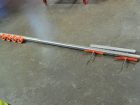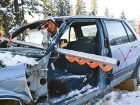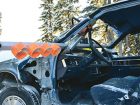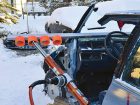
Features
Training
Extrication Tips: January 2015
With advancements in automobile-safety technology over the last 10 to 15 years, steady progress has been made in the development of techniques to safely remove passengers from motor-vehicle collisions. Today, most emergency response personnel use established methods of extrication, such as dash lifts, side-outs and roof removals.
January 6, 2015
By Randy Schmitz
In general, these standardized methods work well for typical crashes that rescuers encounter. But what happens when the crash forces are beyond the thresholds of high-strength steels and engineered crumple zones? What happens when intrusion into the passenger compartment is severe enough that the standard extrication techniques are simply not enough? I think it’s safe to say that most rescuers have responded to a collision that caused them to scratch their heads and wonder how to tackle the extrication.
In Alberta, the Sundre Fire Department has faced this situation. One motor vehicle accident responders encountered was the result of a 45-degree frontal offset collision that trapped the driver by the upper and lower A pillar. The intrusion was deep enough into the passenger compartment that a traditional dash roll with hydraulic rams would not allow the rescue crews to effectively manage the metal in order to push it away from the trapped patients. As well, the typical modified dash lift from the driver’s-side lower A pillar with hydraulic spreaders did not create enough space to displace the metal away from the patients for removal. Extrication crews were left with no alternative but to peel the onion – meaning to remove the metal around the patient layer-by-layer and piece-by-piece, which was a painstakingly long and frustrating process.
In response to that scenario – with necessity being the mother of invention – firefighter Frank Crouch came up with a solution to help in frontal offset crashes.
“The biggest challenge we encountered was that the drivers’ A pillar in these types of crashes is basically not in the position it needs to be in to get a good push off of with a hydraulic ram in order to move it away or to gain access, because it simply isn’t there,” Crouch said.
“I wanted to utilize the stronger vehicle components such as A pillars to place my hydraulic tools in positions where I can apply the proper angle of force to move metal in the direction I want or need it to go, rather than being at the mercy of the tool and hope it moves in the way that it should. . . . This device and method now allows us that control.”
Crouch named the device the Dash-Away. The principle of the Dash-Away is quite basic; it allows accessibility to the A pillar in order to use it for strength to lift the rest of the dash upward or away from entrapped patients. While his device is not yet available commercially, Crouch is working toward that goal.
The Dash-Away is a simple design; it is just over two metres in length and is made out of heavy-duty walled square tubing. Two 10-millimetre course-threaded rods and wing-nut bolts attach to an additional piece of tubing to hold the device in place. Four solid rings are welded to the opposite end to provide an insert for a hydraulic ram head.
The device is inserted directly underneath the driver’s A pillar at the dash area. The opposite end is clamped to the passenger A pillar and secured with the wing nuts and clamp bar. In most cases, the front windshield will need to be removed.
For additional strength, a hydraulic spreader can be used to help secure the device. Be mindful that the spreader will be committed to the evolution and unavailable for use in other tasks. Typical dash-lifting relief cuts will still need to be made at the upper front rail, lower A pillar and lastly, the top section of the upper A pillar.
Depending on the degree of A pillar intrusion into the driver’s area, one of the four florescent rings on the Dash-Away will be used to insert the ram head and push out in the opposite direction.
As the ram is extended, the dash area will start to lift upward. At this point you can reposition the ram head by choosing a ring further to the outside to push it outward or in whichever direction is required to create the proper space.
A rescue team must be able to gain access to patients as swiftly as possible without exposing the patients or themselves to further danger. In order to facilitate this, the crew must be properly trained in all methods of extrication, including the latest devices and tools. In addition, an awareness of vehicle-specific accessibility options and the purpose and process of safety systems is essential.
Randy Schmitz is a Calgary firefighter who has been extensively involved in the extrication field for 23 years. He is an extrication instructor and has competed internationally. He is the education chair for Transport Emergency Rescue Committee (T.E.R.C.) in Canada, a T.E.R.C. & WRO International extrication judge and a tester and evaluator for manufactured prototype products for extrication equipment. He can be reached at rwschmitz@shaw.ca. Follow him on Twitter at @firedog7
Print this page



